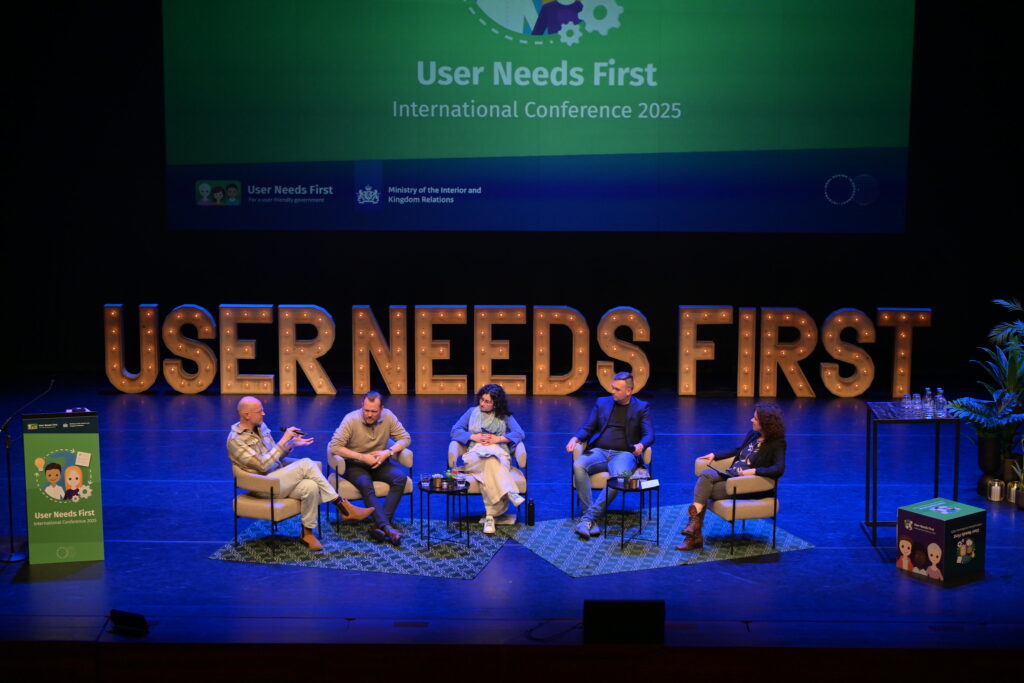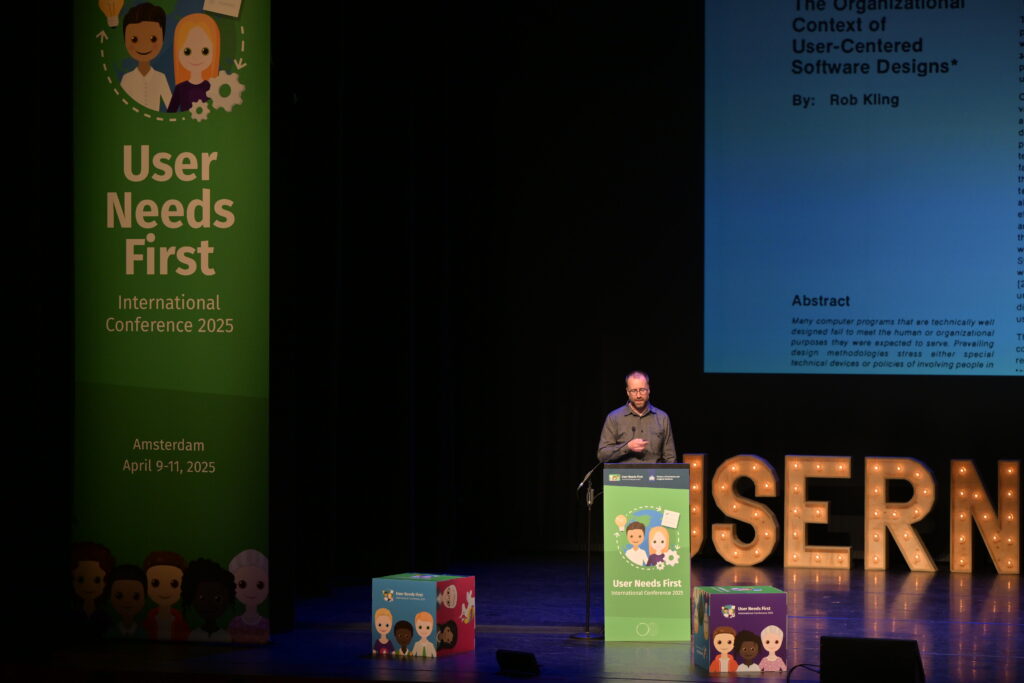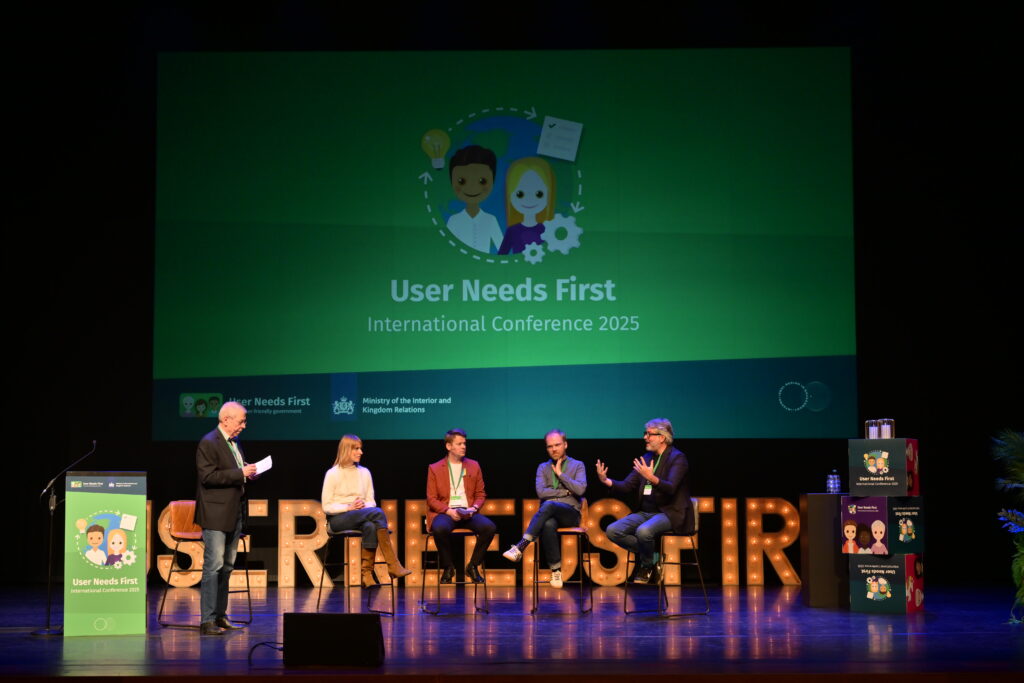The key takeaways of the User Needs First International Conference 2025
What happens when governments around the world come together to put people before process? At the User Needs First International Conference 2025, we found out.
Over 3 days of keynotes, panel discussions, and deeply human conversations, 1 truth rang clear: public service design is growing up. Around the globe, teams are moving beyond checklists and digital dashboards to ask harder, better questions. Not just “How do we build this?” but “Should we?”
If you missed the conference – or just want to revisit the highlights – here are our 5 key takeaways, followed by 5 thought-provoking, not so obvious insights you don’t want to overlook.

5 Takeaways that stood out
1. Put people first, not processes
A foundational but still urgent reminder: designing public services starts with understanding real lives, not optimizing internal procedures. As several speakers noted, systems often prioritize legal clarity or departmental flow over human needs. But as Martijn Lentz (Practice Lead Customer Experience at the Netherlands Chamber of Commerce) emphasized during the panel discussion on mature human-centered government organizations: we should begin by imagining the ideal citizen experience, then redesign internal systems to support that vision.
Stephanie Kaiser (keynote speaker and Chief Product Officer at the German government’s Digital Service) echoed this with an example from German tax services: “You don’t need another chatbot, you need to ask what people actually need to solve.” And that often starts outside the boundaries of your current org chart.
2. Break down silos with culture, not just org charts
Structural silos are only part of the problem, cultural silos are just as damaging. Richard Pope and others pointed out that users shouldn’t have to understand how government is structured just to get help. But too often, internal boundaries become visible in the user experience.
This reflects what’s known as Conway’s Law: systems tend to mirror the structure of the teams that build them. So if your teams are siloed, your services probably are too. As Fredrik Scheide (Special Advisor at the Norwegian Labour and Welfare Administration Nav) put it: “You need to find the legal framework that supports your argument. Not persuade people with your personal conviction, but with the law. Jurists can’t rank values, but they can follow legislation.”
Cecília Barreto de Almeida (Ph.D. Researcher – Human Rights and Digital Government 4th the Dutch Rijksuniversiteit Groningen and Universidade de São Paulo) added: “Trust is the foundation.” And building trust starts with aligning culture and collaboration behind a shared purpose.
3. Balance digital ambition with inclusion
Digital transformation is important, but digital-only design can create exclusion by default. “If public services become digital-only,” warned Maurits Ippel of the Dutch Ombudsman during the panel discussion on digital and non-digital public service, “they create inequality by design.” Citizens must be able to choose their channel, and every channel must be equally usable and intentional.
This isn’t just a moral point, it’s a strategic one. Jake Blok (Co-founder & Board member of the Digital Rights House Foundation) emphasized that older adults, for example, aren’t a fringe group: they’re becoming the majority user group for many public services.
4. Don’t hide complexity, expose it thoughtfully
Public services are complex, and sometimes they should feel that way. “Democracy is government by explanation,” said Richard Pope (keynote speaker and part of founding team of UK Government Digital Service (GDS)). If services are too seamless, we risk hiding power structures, responsibilities, and rules that people need to understand in order to participate.
Charlotte Vorbeck (Principal UX Designer at the Digital Service of the German government) reinforced this: “Even partial digital services, delivered thoughtfully, can still have real impact.” Clarity beats smoothness when it comes to fairness.
Transparency doesn’t always feel efficient, but it builds legitimacy.
5. Design with democracy in mind
Efficiency is not the only – or even the most important – measure of success. Public services are part of our democratic infrastructure. That means they must support participation, not just execution. Richard Pope reminded us: “Design for participation, not just use.” That means building systems that allow for feedback, accountability, and user agency, not just frictionless clicks.

Less obvious takeaways
These insights may have flown under the radar, but they stuck with us. And they’re shaping the future of human-centered public service.
1. We rely too much on our own moral compass
Fredrik Scheide offered a necessary challenge: designers often rely on their own values to justify decisions. But in complex government settings, you need to speak the language of law, finance, or strategy – not just ethics.
For too long, design has been viewed as a creative endeavor – important, yes, but often disconnected from the realities of business. That needs to change. Design should be a key driver of business success.
– Fredrik Scheide
This isn’t about removing emotion from the work, it’s about making your case in terms your stakeholders understand. Want to convince a jurist? Don’t argue that something “feels right.” Show them the relevant section of the law. That’s the language that moves systems.
2. Government is not a service business
Public services are not market products. They’re not optimized for profit or seamlessness; they’re moments of care, conversation, and legal consequence. As Harry van Zon (former director general, Dutch national government) said during the panel discussion ‘Digital versus (and!) non-digital public service’: “Government services are human moments, not market products.”
Smooth digital experiences can hide complexity, power, and responsibility. In public services, clarity and transparency matter more than frictionless UX.
– Richard Pope
Seamlessness is not always democratic. Sometimes, a little friction is necessary – to expose process, to allow reflection, or to make sure rights are protected.
“I felt like I didn’t exist,” Shanna de Freitas said during the panel discussion ‘Cooperation across government: How to escape the silos’. She had to repeat her trauma multiple times to different agencies who didn’t talk to each other. That’s the cost of disconnected systems. “It felt like the burden was on me to prove I was real.”
Empathy – not efficiency – is the way out. And that starts with listening.
3. Design with care, not speed
It’s tempting to chase quick wins, but good design takes time. Charlotte Vorbeck made the case for thoughtful, partial solutions – especially when building full infrastructure isn’t feasible. “Design with care, not speed,” she urged during the panel discussion ‘Digital versus (and!) non-digital public service’.
This doesn’t mean being slow for the sake of it. It means being deliberate, inclusive, and conscious of long-term impact. As several speakers noted, slow design is often more respectful.
4. Reframe what ‘user’ really means
Stephanie Kaiser asked us to rethink who we mean when we say ‘user’. Not just citizens, but also caseworkers, judges, and internal staff. And not just those with ‘disabilities,’ but people with ability variations. Language shapes design, and inclusion starts with how we talk.
Inclusive public services require thinking beyond ‘end users’ to the full ecosystem of people involved in delivery.
5. Seamless isn’t always fair
This insight builds on Richard Pope’s keynote: complexity isn’t always a problem to be solved. In many public services, hiding complexity can actually harm users, especially when it conceals accountability or creates a black box around decisions.
Making public services explainable is part of making them trustworthy.

So, where do we go from here?
Change is slow. Systems are sticky. But this conference proved that progress is possible, especially when we stop chasing perfection and start shipping small, thoughtful wins.
As Stephanie Kaiser said: “Hope through action.”
Whether you’re in policy, design, tech, or operations; your job is to listen deeply, build with care, and never forget the people behind the pixels.
